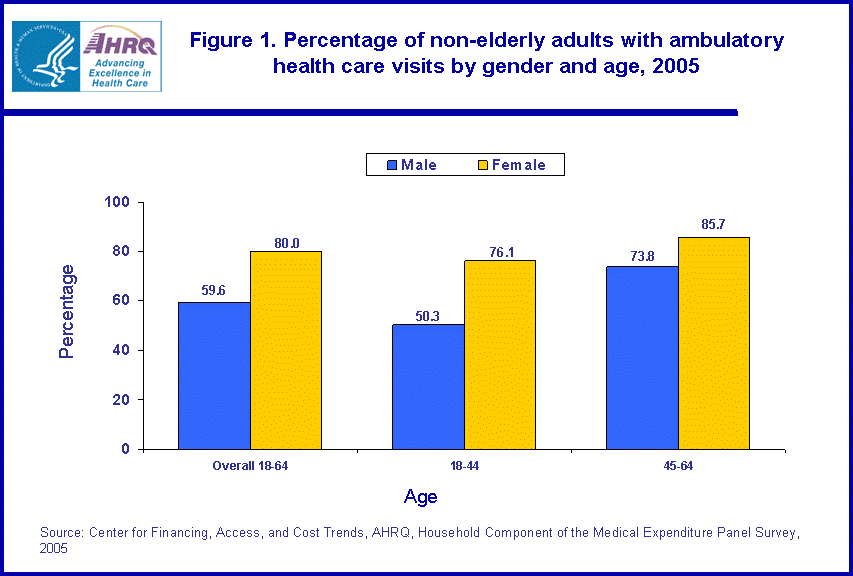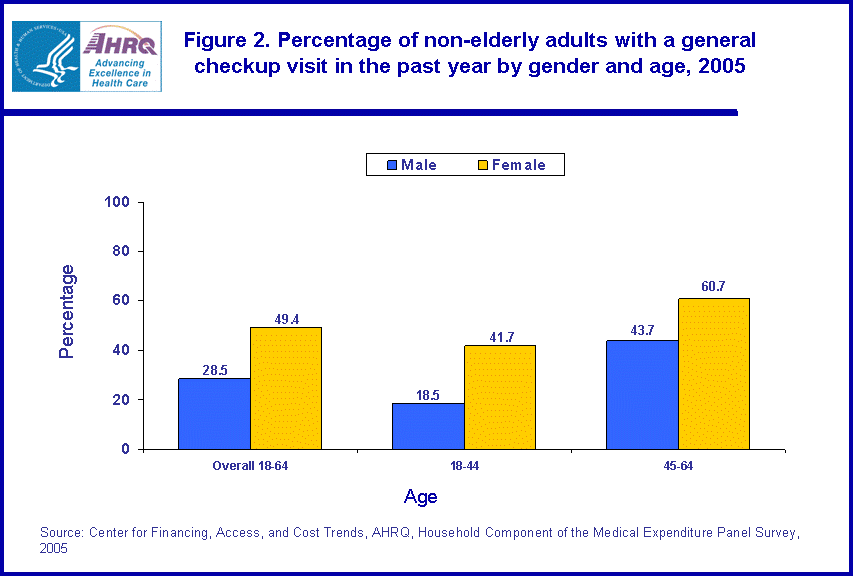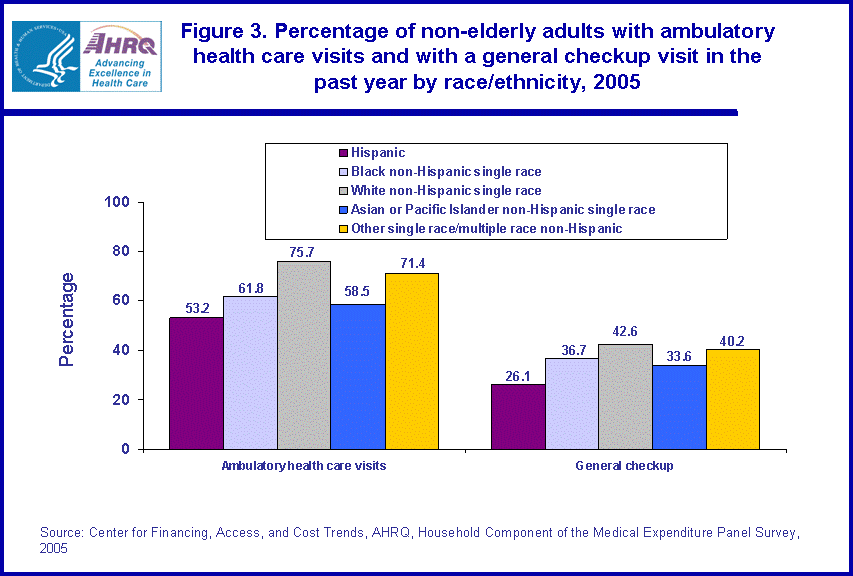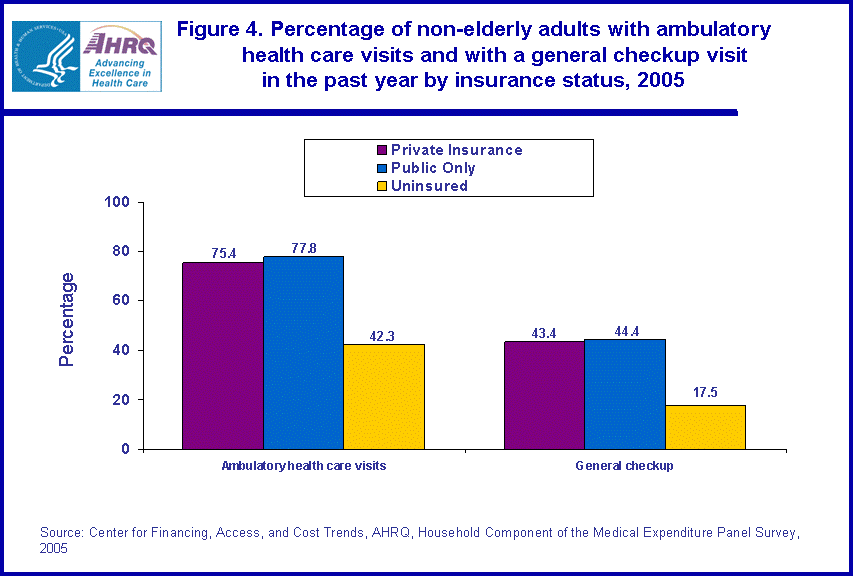
|
|
Font Size:
|
||||
|
|
|
|
||||
STATISTICAL BRIEF #201:
Variation in Ambulatory Health Care Visits and Visits for General Checkup by Demographic Characteristics and Insurance Status, U.S. Civilian Noninstitutionalized Population Ages 18-64, 2005
Highlights
- Women ages 18-64 were more likely than men ages 18-64 to have an office-based or outpatient health care visit in 2005 (80.0 percent versus 59.6 percent).
- About one-half of women (49.4 percent) ages 18-64 had a visit for a general checkup in 2005 compared to only 28.5 percent of men ages 18-64.
- Non-Hispanics ages 18-64 (regardless of their race) were more likely to have had an ambulatory health care visit as well as a general checkup in comparison to Hispanics of the same age.
- In 2005, non-elderly adults with private insurance as well as those with public only insurance were more likely than their uninsured counterparts to have an office-based visit (75.4 percent and 77.8 percent versus 42.3 percent, respectively). Non elderly adults with private insurance or public only insurance were also more likely to have had a general checkup (43.4 percent and 44.4 percent, respectively) when compared to uninsured non-elderly adults (17.5 percent).
Introduction
This Statistical Brief examines the differences between men and women in ambulatory health care visits (office based and hospital outpatient) and visits made for a general checkup. The comparisons between men and women are for all non-elderly adults ages 18-64 in the U.S. civilian noninstitutionalized population in 2005 as well as for those ages 18-44 and ages 45-64. This Brief also provides estimates of ambulatory health care visits and visits made for a general checkup by race/ethnicity and insurance status for persons ages 18-64. The estimates are derived from the Household Component of the 2005 Medical Expenditure Panel Survey (MEPS-HC). Only differences between estimates that are statistically significant at the 0.05 level are discussed in the text.
Findings
Among adults ages 18-64, women were more likely than men to have an office-based or outpatient health care visit in 2005. More specifically, 80.0 percent of women had one or more ambulatory health care visits compared to only 59.6 percent of men. About three-quarters (76.1 percent) of younger adult women ages 18-44 had ambulatory health care visits versus only half (50.3 percent) of their male counterparts. While women ages 45-64 were also more likely than men ages 45-64 to have one or more ambulatory health care visits (85.7 and 73.8 percent, respectively), the magnitude of the difference for this age group was much less than the observed differential for younger adults (figure 1).
Women ages 18-64 with at least one ambulatory health care visit in 2005 had a higher mean number of visits than men (8.7 versus 6.8). The relative differential in the mean number of visits between females and males was comparable for persons ages 18-44 (7.1 visits for females and 5.5 visits for men) and for persons ages 45-64 (10.7 visits for females and 8.2 visits for males). (Data not shown in figure).
About half of women (49.4 percent) ages 18-64 had a visit for a general checkup in 2005 compared to just 28.5 percent of men ages 18-64. Younger adult women ages 18-44 were twice as likely as their male counterparts to have had a general checkup (41.7 percent of women versus 18.5 percent of men). This relative differential among women and men was smaller among the 45-64 year old age group with 60.7 percent of women and 43.7 percent of men having had an ambulatory checkup visit (figure 2).
Hispanic adults ages 18-64 were less likely to have an office-based or outpatient health care visit compared to black non-Hispanics single race, white non-Hispanics single race, Asian or Pacific Islander non-Hispanics single race, or other single race/multiple race non-Hispanics. Hispanics were also the least likely to have had an ambulatory visit for a general checkup during 2005 (figure 3).
Among non-elderly adults with private insurance, 75.4 percent had an office-based visit in 2005; among those with public only insurance 77.8 percent had an office-based visit. In comparison, only 42.3 percent of uninsured non-elderly adults had an office-based visit in 2005. Non-elderly adults with private insurance or public only insurance were also more likely to have had a general checkup (43.4 percent and 44.4 percent, respectively) when compared to uninsured non-elderly adults (17.5 percent) (figure 4).
Data Source
The estimates shown in this Statistical Brief were produced by MEPS staff from the 2005 office based and outpatient event files, HC-094F and HC-094G, and the 2005 Full Year Consolidated Data File, HC-097, which are available on the MEPS Web site, http://www.meps.ahrq.gov.
Definitions/Methodology
Population
The statistics are for people who lived in the community for all or part of the year and were ages 18-64.
Age
Age is that of the sample person as of December 31 of the reported year.
Ambulatory health care visit
For purposes of this Statistical Brief, an ambulatory health care visit is defined as any visit to an office-based medical provider or a hospital outpatient facility.
Reasons for visit
For each health care event reported by MEPS respondents, various reasons for the visit are obtained. This Statistical Brief uses the general checkup reason for visit category.
Race/ethnicity
Classification by race/ethnicity was based on information reported for each family member. Respondents were asked if each family member's race was best described as American Indian, Alaskan Native, Asian or Pacific Islander, black, white, or other. They also were asked if each family member's main national origin or ancestry was Puerto Rican; Cuban; Mexican, Mexicano, Mexican-American, or Chicano; other Latin American; or other Spanish. All persons whose main national origin or ancestry was reported in one of these Hispanic groups regardless of racial background were classified as Hispanic. Since the Hispanic grouping can include black, Hispanic, white Hispanic, Asian and Pacific Islanders Hispanic, and other Hispanic, the race categories of black, white, Asian and Pacific Islanders, and other do not include Hispanic. MEPS respondents who reported other single or multiple races and were non-Hispanic were included in the other category. For this analysis, the following classification by race and ethnicity was used: Hispanic (of any race), black non-Hispanic single race, white non-Hispanic single race, Asian and Pacific Islander non-Hispanic single race, and other single race/multiple race non-Hispanic.
Insurance status
Insurance categories are hierarchical. Private insurance includes anyone who had any private insurance (including TRICARE) at any time during the year. Public only insurance includes anyone who had public only insurance at any time during the year. Uninsured refers to people who did not have any private or public insurance at any time during the year.
About MEPS-HC
The Medical Expenditure Panel Survey Household Component (MEPS-HC) is a nationally representative longitudinal survey that collects detailed information on health care utilization and expenditures, health insurance, and health status, as well as a wide variety of social, demographic, and economic characteristics for the civilian noninstitutionalized population. It is cosponsored by the Agency for Healthcare Research and Quality and the National Center for Health Statistics.
For more information about MEPS, call the MEPS information coordinator at AHRQ (301-427-1656) or visit the MEPS Web site at http://www.meps.ahrq.gov/.
References
For a detailed description of the MEPS-HC survey and sample design, and methods used to minimize sources on nonsampling error, see the following publications:
Cohen, J. Design and Methods of the Medical Expenditure Panel Survey Household Component. MEPS Methodology Report No. 1. AHCPR Pub. No. 97-0026. Rockville, MD.: Agency for Healthcare Policy and Research, 1997. http://www.meps.ahrq.gov/mepsweb/data_files/publications/mr1/mr1.shtml
Cohen, S. Sample Design of the 1996 Medical Expenditure Panel Survey Household Component. MEPS Methodology Report No. 2. AHCPR Pub. No. 97-0027. Rockville, MD.: Agency for Healthcare Policy and Research, 1997. http://www.meps.ahrq.gov/mepsweb/data_files/publications/mr2/mr2.shtml
Cohen, S. Design Strategies and Innovations in the Medical Expenditure Panel Survey. Medical Care, July 2003; 41(7) Supplement: III-5-III-12.
Ezzati-Rice, TM, Rohde, F, Greenblatt, J, Sample Design of the Medical Expenditure Panel Survey Household Component, 1998-2007. Methodology Report No. 22. March 2008. Agency for Healthcare Research and Quality, Rockville, MD. http://www.meps.ahrq.gov/mepsweb/data_files/publications/mr22/mr22.pdf
Suggested Citation
Ezzati-Rice, TM, Rohde, F. Variation in Ambulatory Health Care Visits and Visits for General Checkup by Demographic Characteristics and Insurance Status, U.S. Civilian Noninstitutionalized Population Ages 18-64, 2005. Statistical Brief #201. March 2008. Agency for Healthcare Research and Quality, Rockville, MD http://www.meps.ahrq.gov/mepsweb/data_files/publications/st201/stat201.pdf
AHRQ welcomes questions and comments from readers of this publication who are interested in obtaining more information about access, cost, use, financing, and quality of health care in the United States. We also invite you to tell us how you are using this Statistical Brief and other MEPS data and tools and to share suggestions on how MEPS products might be enhanced to further meet your needs. Please e-mail us at mepspd@ahrq.hhs.gov or send a letter to the address below:
Steven B. Cohen, PhD, Director
Center for Financing, Access, and Cost Trends
Agency for Healthcare Research and Quality
540 Gaither Road
Rockville, MD 20850
 |
||||||||||||||||||||||||
|
||||||||||||||||||||||||
|
|
||||||||||||||||||||||||
 |
||||||||||||||||||||||||
|
||||||||||||||||||||||||
|
|
||||||||||||||||||||||||
 |
||||||||||||||||||||||||
|
||||||||||||||||||||||||
|
|
||||||||||||||||||||||||
 |
||||||||||||||||||||||||
|
||||||||||||||||||||||||
|
|
||||||||||||||||||||||||


